12 Ways To Get Paid To Share Links Online

So you’re scrolling through social media anyway, right? What if I told you those hours could actually pay your bills instead of just draining your battery?
Look, I get it. The idea of making money by simply dropping links sounds almost too good to be true, like one of those “lose 20 pounds in 3 days” schemes.
But here’s the thing: link sharing is legitimate, and people are cashing checks from it every single month.
Some are making beer money; others are replacing their full-time income. The difference? They know which platforms actually pay and which ones are just wasting their time.
I first came across the idea of getting paid to share links while exploring online side hustles.
At first, it sounded too simple to be true, but after testing a few platforms, I realized it actually works when done right. I
It taught me that the internet rewards those who know how to connect people with what they need.
I’m going to be straight with you. Not every link-sharing gig is created equal. Some pay pennies while demanding hours of your time.
Others? They’re absolute goldmines if you know how to work them. After spending years in finance and watching people build genuine income streams online, I’ve seen what works and what doesn’t.
This isn’t about getting rich overnight. It’s about understanding how money flows through these platforms and positioning yourself to catch some of that flow.
Whether you need an extra $200 for groceries or you’re building toward something bigger, this guide breaks down 12 real ways to get paid for sharing links, plus the actual strategies that turn clicks into cash.
What Is Link Posting And How Does It Work?
Think of link posting as digital matchmaking. You’re connecting people who need something with businesses that provide it.
Every time you drop a link, you’re creating a bridge. And when someone crosses that bridge to make a purchase or sign up for something, you get paid for building it.
The mechanics are refreshingly simple. A company gives you a unique URL that tracks every click, sign-up, or sale that comes through it.
Share that link wherever your audience hangs out. When someone takes action, the tracking system credits your account. Money appears.
What makes this different from just randomly sharing stuff? The tracking. These aren’t regular links; they’re embedded with technology that follows user behaviour.
Companies can see exactly which sale came from your link versus someone else’s. That’s why they’re willing to pay you.
The payment models vary. Some platforms pay you for every click, even if the person doesn’t buy anything.
Others only pay when someone completes a specific action, signing up, making a purchase, or subscribing to a service. A few even pay you recurring commissions if customers stick around and renew.
Here’s what matters from a financial perspective: your conversion rate and your commission structure determine your earnings.
You could get 10,000 clicks on a low-converting link and make less than 100 clicks on a high-converting one. Understanding this ratio changes everything about how you approach link sharing.
Different Payment Structures You Need To Know
Pay-per-click means you earn small amounts (often a few cents) every time someone clicks your link. The upside? You get paid regardless of whether they buy.
The downside? You need massive traffic to make real money.
Referral programs pay you when someone signs up or registers through your link.
These typically pay more than simple clicks because you’re delivering qualified leads, not just random traffic.
Affiliate commissions are where the real money lives. You earn a percentage of every sale made through your link.
If you’re promoting a $1,000 course at 20% commission, one sale nets you $200. That’s dramatically different from earning $0.03 per click.
The key is matching your traffic source to the right payment model.
Social media with casual scrollers? Pay-per-click might work. Engaged email list? Go for affiliate commissions every time.
12 Ways To Get Paid To Share Links Online
Alright, let’s get into the actual platforms and networks that put money in your account.
I’m breaking these down into two categories: companies that pay directly and networks that connect you with multiple brands.
Companies That Pay You To Share Links
These platforms handle everything in-house. You sign up with them directly, get your links, share them, and they cut your checks.
1. Linkvertise
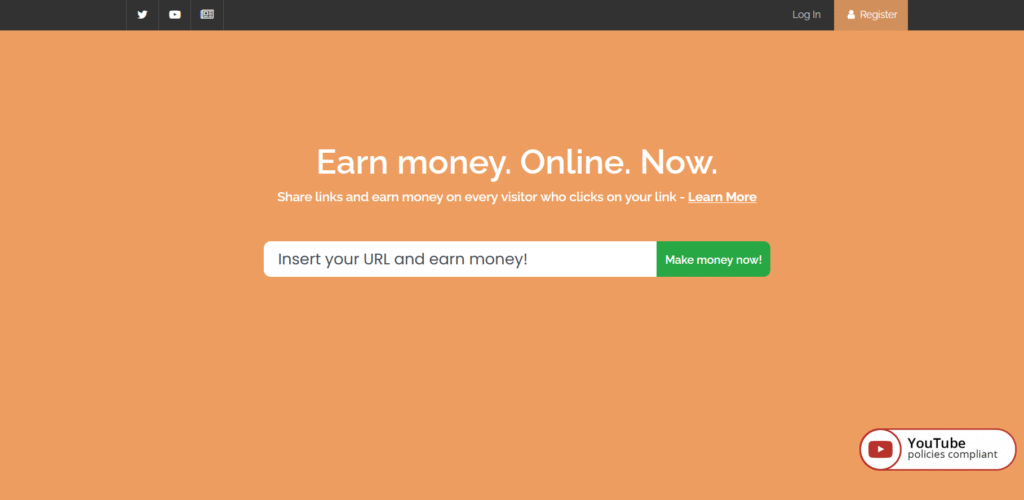
Linkvertise operates on an interesting model that honestly annoys some users but pays you consistently. When someone clicks your shortened link, they hit an ad layer first.
Maybe they watch a quick video, solve a CAPTCHA, or click through an article. Then they reach the actual destination.
You earn money from these ad interactions. The amount varies based on where your traffic comes from; visitors from high-income countries pay more.
Expect anywhere from $1 to $10 per thousand clicks, depending on your traffic quality.
The platform works best if you’re sharing genuinely useful content that people are willing to sit through an ad to access.
Try this with clickbait garbage and you’ll burn through your audience trust faster than you can say “passive income.” 🙂
From my experience analysing digital revenue streams, Linkvertise succeeds when you’re strategic about placement.
Share links to exclusive downloads, helpful resources, or sought-after information. People will tolerate one ad layer for something they actually want.
2. Linkbucks
Linkbucks pioneered this whole ad-based link shortening thing. They’ve been around long enough that their payment systems are reliable, which matters when you’re trusting someone with your earnings.
Their rates follow standard CPM and CPC models. Countries like the US, UK, and Canada generate higher payouts because advertisers pay more to reach those audiences. Traffic from other regions still pays, just less.
Here’s something most people miss: Linkbucks pays better for certain content types.
Tech downloads, gaming content, and software tutorials tend to generate higher-quality clicks that advertisers value more.
If your audience fits those niches, you’re looking at better earnings per click.
The referral system adds another income layer. Bring in other publishers, and you earn a cut of their earnings too.
It’s passive income on top of passive income, always a smart move financially.
3. Wordlinx
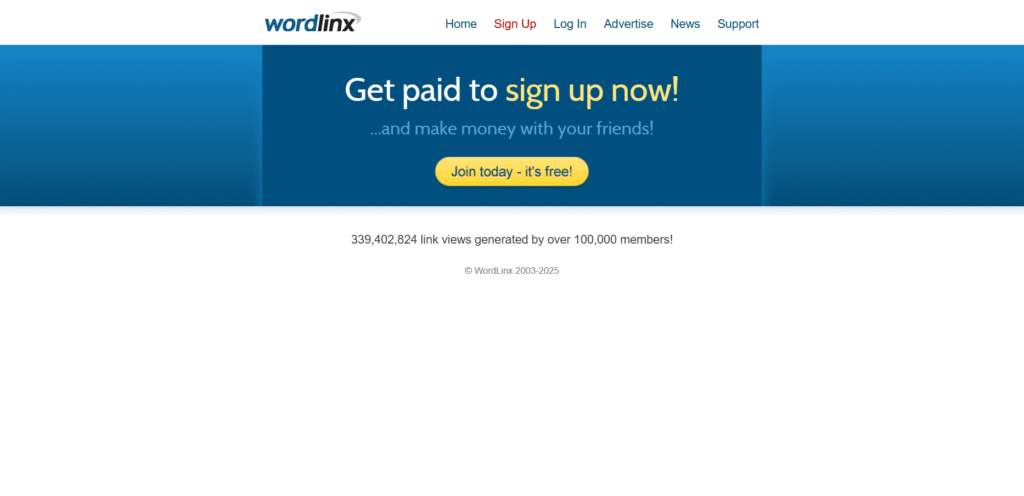
Wordlinx combines link sharing with paid-to-click advertising.
You earn when people view sponsored links you share, and there’s verification built in to ensure clicks are legitimate.
What I appreciate from a financial integrity standpoint is their focus on verified clicks.
Too many platforms pay for bot traffic that benefits nobody except fraudsters.
Wordlinx actually checks that real humans are clicking, which means advertisers stick around and keep funding the platform.
The referral bonuses here can seriously multiply your earnings.
Multi-level referral structures mean you earn from people you bring in and people they bring in.
Build a solid downline, and you’re earning while you sleep.
Payment processing is straightforward.
There are no weird delays or sudden rule changes that leave you unpaid.
For anyone building this as a reliable income stream, consistency matters more than occasional high payouts.
4. Amazon
The Amazon Associates program is basically the gold standard of affiliate marketing.
Why? Because everyone shops on Amazon. You’re not convincing people to try some random website; they already trust it.
Commission rates range from 1% to 10% depending on the product category.
Electronics tend to have lower percentages.
Luxury beauty offers much higher rates.
Smart affiliates focus on categories with better commission structures.
Here’s a strategy most people miss.
Amazon’s 24-hour cookie window means you earn commission on anything someone buys within 24 hours of clicking your link, even if it’s not the product you promoted.
Someone clicks your link for a $15 book but ends up buying a $500 TV. You earn commission on the TV.
The sheer variety of products makes it easy to weave Amazon links naturally into content.
Product reviews, comparison posts, gift guides it all works. Plus, the brand recognition means higher conversion rates than lesser-known retailers.
5. Surfshark
Surfshark’s affiliate program targets the cybersecurity market, which is growing faster than most people realise.
As data breaches and privacy concerns escalate, VPN services are transitioning from niche products to mainstream necessities.
Commissions here are notably higher than in many programs. We’re talking $50+ per sale, not the $5 typical of low-ticket items.
And here’s the kicker: recurring commissions. When customers renew their subscriptions, you get paid again.
That transforms one-time sales into ongoing revenue streams.
The conversion rates are solid because Surfshark invests heavily in its product. It actually works well, costs less than competitors, and solves a real problem.
When you’re promoting something that delivers value, selling becomes much easier.
FYI, the privacy and security angle resonates strongly right now. People are genuinely concerned about online tracking and data collection.
You’re not pushing something frivolous; you’re helping people protect themselves.
6. ClickBank
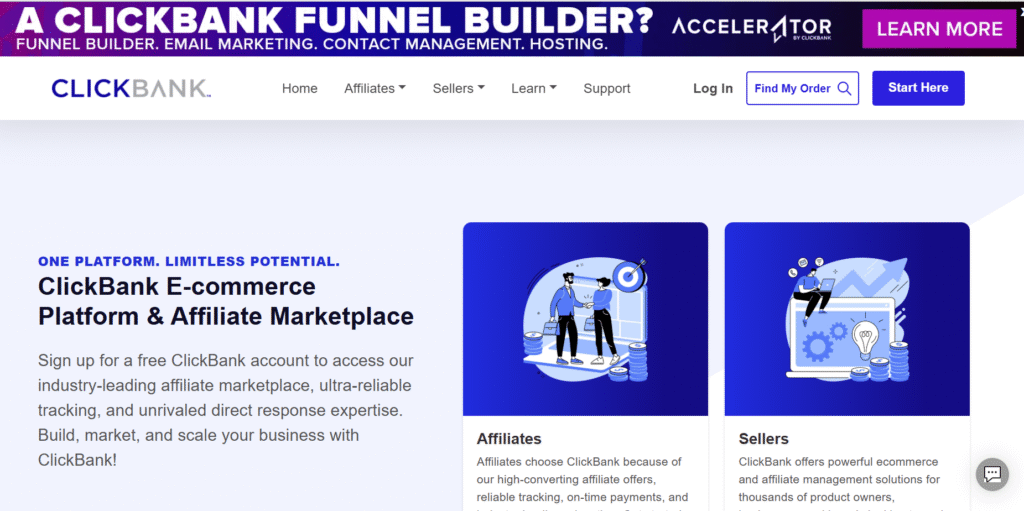
ClickBank dominates the digital product marketplace. E-books, online courses, software, membership sites, if it’s digital and profitable, it’s probably on ClickBank.
Commission rates often hit 50% or higher. Yes, you read that right.
Digital products have virtually no fulfilment costs, so creators can afford to split revenue generously with affiliates who bring in sales.
The marketplace structure makes product selection easy. You can browse by category, sort by popularity, check gravity scores (which indicate how many affiliates are successfully selling the product), and analyse commission structures before deciding what to promote.
Weekly payouts keep cash flowing regularly.
Some platforms make you wait 60+ days for payment. ClickBank puts money in your account every seven days once you hit the minimum threshold.
One warning, though: product quality varies wildly on ClickBank.
Some offerings are fantastic; others are overpriced garbage. Your reputation is on the line with every link you share, so vet products carefully before promoting them.
7. Google AdSense
Google AdSense operates differently from traditional link sharing, but it deserves mention because it monetises your existing content through ad placement.
You embed ads on your website or blog. Visitors click those ads. You earn money. The beauty is that once ads are placed, the system runs automatically.
Google handles advertiser relationships, ad selection, and payment processing.
The earnings potential here scales with traffic. A site pulling 10,000 monthly visitors might generate $200-500 monthly, depending on niche and ad placement.
Increase that to 100,000 visitors and you’re looking at $2,000-5,000 or more.
High-value niches pay substantially more per click. Finance, insurance, legal services, and B2B software generate clicks worth $5-50 each.
Entertainments and lifestyle content? Maybe $0.10-0.50 per click. Choose your content topics strategically if earnings matter.
The indirect link-sharing angle: create great content on your site, share those pages on social media, and drive traffic back to your monetised site.
You’re technically sharing links to your own content, which contains the money-making ads.
Networks That Pay You To Share Links
These platforms connect you with hundreds or thousands of brands. One approval gives you access to tons of programs.
8. Rakuten
Rakuten Advertising connects you with major retailers like Walmart, Best Buy, Macy’s, and Sephora. These aren’t obscure brands nobody’s heard of; these are household names with established reputations.
The application process requires approval for individual brand programs within the network.
Some accept you immediately, others review your traffic and content first. Higher-quality sites get access to premium programs with better commission rates.
Cookie duration varies by merchant. Some track purchases for 24 hours, others for 30+ days.
Longer cookie windows increase your chances of earning commissions because people rarely buy immediately; they research, compare, and return later.
Rakuten’s reporting tools are sophisticated. You can track clicks, conversions, and earnings in real-time, analyse which products perform best, and optimise your strategy based on actual data instead of guessing.
9. Shopify
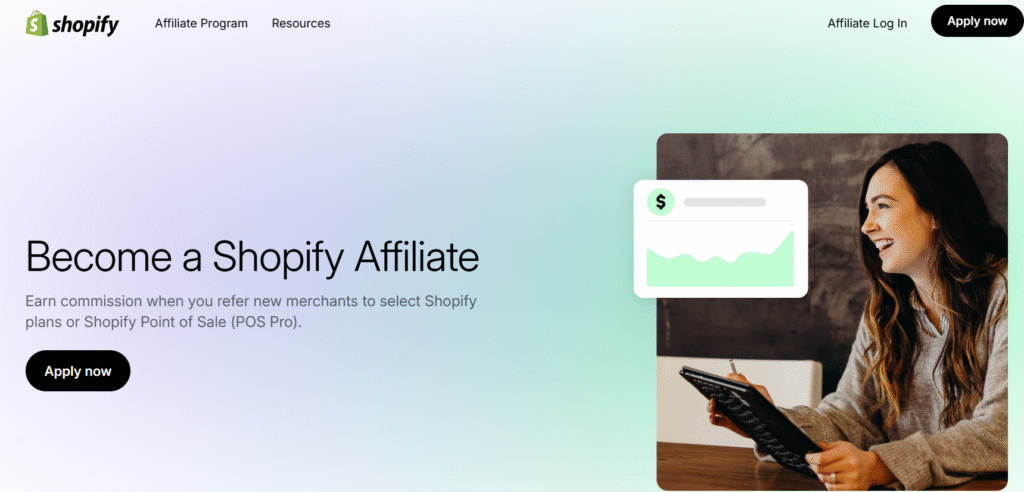
If you’re targeting entrepreneurs or the e-commerce crowd, Shopify’s affiliate program makes perfect sense. Every new online store needs a platform, and Shopify dominates that market.
You earn commissions when people sign up for paid Shopify plans through your referral link. The average commission is around $58 per referral, but it can go higher for enterprise plans.
What makes this attractive is the target audience. People starting businesses are in investment mode; they’re spending money to make money.
That mindset translates to higher conversion rates compared to promoting consumer products to casual browsers.
The content opportunities are endless. Business startup guides, e-commerce tutorials, side hustle articles, dropshipping explanations, all of these naturally incorporate Shopify as the recommended platform.
10. NordVPN Affiliate Program
NordVPN competes directly with Surfshark in the VPN space. Their affiliate program is equally lucrative, sometimes paying even more depending on the plan someone purchases.
The 30-day cookie window gives you a full month to convert someone. Most purchase decisions happen within days, but some people research extensively before committing.
That extended tracking period ensures you’re credited even if someone takes their time deciding.
Recurring commissions again make this valuable. One successful referral can pay you multiple times over the years if the customer stays subscribed.
That’s the difference between transactional income and building actual assets that generate ongoing cash flow.
The brand recognition helps tremendously with conversions. NordVPN invests millions in marketing and partnerships, so potential customers have often heard of them before clicking your link.
You’re not starting from zero awareness.
11. ShareASale
ShareASale gives you access to thousands of merchants across virtually every niche imaginable. Fashion, technology, home goods, pet supplies, fitness equipment, it’s all here.
Commission rates vary dramatically by merchant. Some pay 5%, others pay 50%+. The key is finding products that match your audience AND pay well.
A 50% commission means nothing if nobody wants to buy that product.
The approval process requires you to register with ShareASale first, then apply to individual merchant programs. Some approve you instantly, others review your traffic and content quality.
Building a legitimate platform with real traffic gets you approved faster.
Exclusive high-paying programs reward top performers. Once you prove you can drive sales, you gain access to offers that aren’t available to everyone.
These often include higher commission rates, special promotions, and dedicated support.
The downside is that without consistent traffic, earnings can be minimal. This isn’t a “sign up and make money” situation.
You need an audience, and that audience needs to be engaged enough to click your links and make purchases.
12. FlexOffers
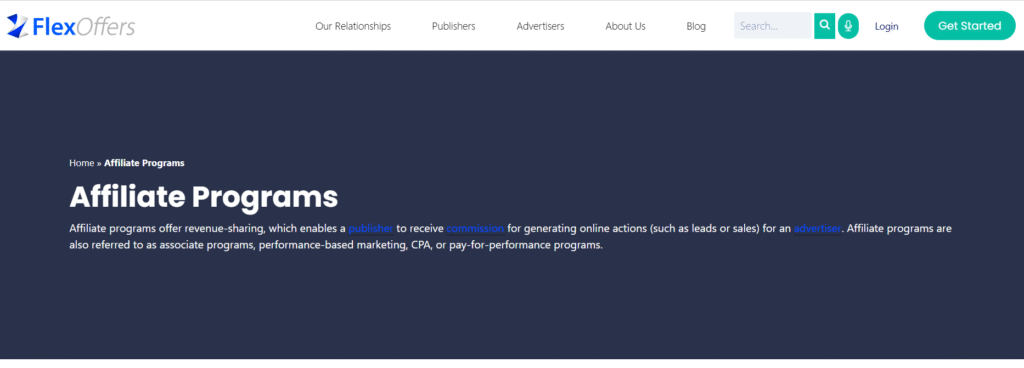
FlexOffers operates a massive network connecting publishers with 12,000+ advertisers. The variety means you can find programs matching almost any niche or audience.
Their faster payout system is worth highlighting. Many networks hold payments for 60-90 days to account for returns and refunds. FlexOffers processes payments more quickly once you’re established, which helps with cash flow.
The automated optimisation tools help maximise earnings without constant manual tweaking. The system analyses which products perform best with your audience and can adjust recommendations accordingly. It’s like having an algorithm working to increase your income.
Commission rates depend entirely on the advertiser. Some are generous, others are stingy. The smart move is testing multiple programs within your niche to identify which ones convert well AND pay fairly.
Places To Share Links To Make Money
Knowing WHERE to drop your links is just as crucial as knowing WHAT to promote. Your conversion rate depends heavily on matching the right platform to your content type and audience behaviour.
1. Social Media
Social platforms offer massive reach, but each one requires a different approach. What works on Pinterest fails on Twitter, and TikTok has its own unique culture.
Facebook works best in groups where people are actively seeking recommendations. Find communities related to your niche, provide genuine value through helpful comments and posts, then share relevant links when appropriate. The Facebook algorithm hates spam, so lead with value.
Instagram limits clickable links to your bio and Stories. Use the “link in bio” strategy with tools that create a landing page of multiple links. Stories with the swipe-up feature (for accounts with 10K+ followers) allow direct linking.
Twitter allows direct links in tweets, but you’ve got limited characters to make your pitch. Focus on punchy, curiosity-driven copy that makes people want to click. Threads perform well for more detailed explanations.
Pinterest is absolutely fantastic for affiliate marketing because people use it with purchase intent. They’re actively looking for products, ideas, and recommendations.
Create eye-catching pins that link to blog posts containing your affiliate links, or use Pinterest’s affiliate-friendly features.
TikTok and YouTube Shorts work well for product demonstrations and reviews. Show the product in action, explain the benefits quickly, and direct people to your bio for the link.
Short-form video is exploding right now, and early adopters are seeing great results.
2. Blogs
A blog is your owned real estate on the internet. Algorithms can’t take it away, rules don’t change overnight, and you control everything about the experience.
Product reviews consistently drive sales because people actively searching for reviews are close to making a purchase decision.
They’re just looking for confirmation that the product works. Your detailed, honest review provides that confirmation.
Comparison posts pit similar products against each other. “Product A vs Product B” or “Top 5 Options for X” naturally incorporate multiple affiliate links while helping readers make informed decisions.
Tutorial content that walks people through solving a problem can include tool recommendations.
“How to Edit Videos” naturally mentions editing software. “How to Lose Weight” incorporates supplements, equipment, or programs.
SEO is non-negotiable for blog success. Ranking on Google drives free, targeted traffic forever.
Write today, rank in three months, earn for years. That’s the power of searchable content.
3. Email Content & Newsletters
Email consistently delivers the highest ROI of any marketing channel. The people on your list permitted you to contact them; they’re warm leads, not cold traffic.
Building a list requires offering something valuable in exchange for email addresses. Free PDF guides, checklists, video training, discount codes, whatever makes sense for your niche.
Newsletter emails should provide value first, sell second. If every email is just a promotion, people unsubscribe. Mix helpful content with occasional product recommendations, and your list stays engaged while generating sales.
Segmentation increases conversions dramatically. Send different offers to different groups based on their interests and behaviours.
The person who clicked on fitness content probably won’t respond to business software promotions.
4. Messaging Apps & Direct Messages
Direct communication channels like WhatsApp, Telegram, Discord, and Facebook Messenger create intimate conversations that can lead to higher conversion rates when used properly.
WhatsApp groups centred around specific interests are goldmines. Join groups related to your niche, contribute value through helpful information, then share relevant links when they genuinely fit the conversation.
Telegram channels let you build an audience that receives your broadcasts. Create a channel focused on your niche, grow it through valuable content, and periodically share monetised links.
The people who joined your channel did so because they want your recommendations.
Discord servers built around specific communities or interests offer numerous opportunities. Create your own server, establish yourself as a helpful authority, and share links when appropriate.
Or join existing servers and contribute value before ever dropping a link.
The key with messaging apps is avoiding spam behaviour. These are personal spaces, and people react negatively to obvious selling.
Build relationships first, provide value consistently, and share links only when they genuinely help people.
Final Thoughts
Making money by sharing links is real, achievable, and potentially rewarding, but it’s not magic. It’s about strategy, consistency, and providing real value while earning commissions.
The formula never changes: higher traffic, better conversions, and higher commissions mean more income. Improve one, and you earn more; improve all three, and you build something lasting.
Start small. Focus on one or two platforms, master them, and generate steady results before expanding.
Spreading yourself too thin kills progress. Always protect your reputation, promote only products you trust, be transparent about their pros and cons, and priorities your audience’s needs.
Quick cash from shady links might pay today, but it destroys long-term credibility.
Most people quit too soon. They post a few links, see no instant results, and assume it doesn’t work. But success takes time, traffic, trust, and conversion, all grow with effort.
Stay adaptable as new platforms and affiliate programs emerge. Pick one method today, create your account, and share your first link this week.
Action builds momentum, and momentum builds income. Go turn those clicks into cash.








